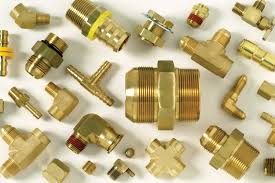 Brass, an alloy of copper and zinc, had been known for many centuries. Zinc is already gaseous at relatively low temperatures. If in ovens with carbon zinc ore is heated, it will escape in gaseous state with the exhaust gases. When a mixture of copper ore and zinc ore is used, zinc vapor will be dissolved directly in the liquid copper. Therefore it’s no problem making brass, but zinc winning is. In India and China around 1,100 was discovered that it could by hanging in the exhaust gases -containing gaseous zinc- a relatively cold object (e.g. an earthenware pot) . The zinc vapor condenses on it.
Brass, an alloy of copper and zinc, had been known for many centuries. Zinc is already gaseous at relatively low temperatures. If in ovens with carbon zinc ore is heated, it will escape in gaseous state with the exhaust gases. When a mixture of copper ore and zinc ore is used, zinc vapor will be dissolved directly in the liquid copper. Therefore it’s no problem making brass, but zinc winning is. In India and China around 1,100 was discovered that it could by hanging in the exhaust gases -containing gaseous zinc- a relatively cold object (e.g. an earthenware pot) . The zinc vapor condenses on it.
In order to avoid that oxygen the metal oxidized again later carbon was added in the form of charcoal. Roasted zinc ore was with charcoal put in a closed retort of burned (Naam’s) pottery. The retort tilted to the outside of the oven down. The furnace was heated at 1,500 to 1,600⁰ Celsius. Zinc oxide was reduced by the outgoing monoxide, zinc vaporized and condensed on the outside in the spur of the retort.
Latoen
Latoen is an old Dutch word from the French "laiton". It is used for various alloys in different ratios of copper with zinc. Also, tin, lead and others (non-magnetic) metals could be added.
It was made by melting powdered calamine ore with charcoal and copper. In the Middle Ages used for coinage, weights and tools.
So the name also refers to brass, especially in the form of foil (latoen copper).
Also an old solder composition of 50 parts tin and 50 parts lead (sometimes with different proportions and additions) was called latoen.
Around 1805 there were zinc factories around Liege. Ore came from mines in Moresnet (Three Country Point). Drop zinc was melted and cast into shapes to solidify into thick plates. Which were placed in a furnace, heated to +120⁰ Celsius and between flattening rollers rolled to the required thickness. Zinc roof had the advantage that the rainwater that is used as drinking water was not contaminated with toxic oxides as with lead, and zinc is lighter. Disadvantages are shrinkage and expansion.
In 1989, the S.A. Vieille Montagne merged with UM. In 1999, the Union Minière went into the multinational Umicore.
